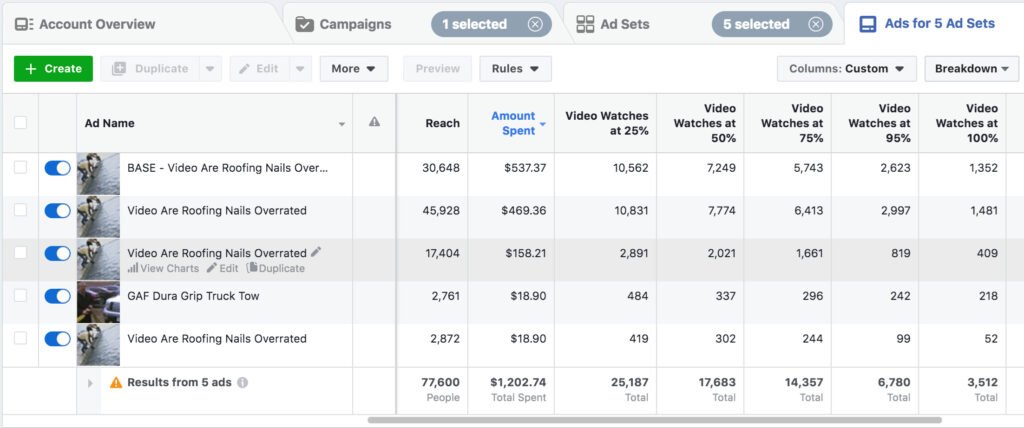How Rocket Launch Media Helps Roofing Companies Drive More Customers with Meta Ads
At Rocket Launch Media, we specialize in helping roofing companies generate high-quality leads and increase sales with data-driven digital marketing strategies. Since 2018, we have worked with roofing contractors of all sizes to transition from traditional advertising to high-converting online marketing campaigns that produce real, measurable results.
Why Every Roofing Business Needs a Digital Marketing Strategy
Having an online presence isn’t enough—you need a strategy that actually drives leads and sales. Many roofing companies waste thousands of dollars on ads without a proper tracking system, leading to mixed results and missed opportunities.
That’s why we developed our AEC Method—Awareness, Engagement, and Conversion—a proven system designed to:
- Attract qualified leads looking for roofing services in their area.
- Build trust with homeowners and business owners who need roofing solutions.
- Convert visitors into booked roofing appointments with optimized digital ads.
In this case study, you’ll see how we:
- Use Meta’s Offline Events tracking to accurately measure sales and attribute ROI from roofing ad campaigns.
- Implement advanced tracking systems to ensure every dollar spent on ads is accounted for.
- Develop high-performing ad creatives and landing pages that convert roofing leads at a higher rate.
👉 Want to see how digital marketing can grow your roofing business? Get a Free Consultation
The #1 Mistake Roofing Companies Make with Facebook Ads
One of the most common frustrations we hear from roofing contractors is:
“We tried Facebook Ads, but they didn’t generate any leads, so we stopped them.”
Our response?
“How did you set up your tracking?”
More often than not, the answer is silence.
Most roofing businesses fail to track their leads and sales properly, which means they have no way of knowing what’s working and what’s not. That’s why the first step in our process is setting up proper tracking, including:
✅ Facebook Pixel to track lead form submissions.
✅ Google Analytics to monitor traffic and user behavior.
✅ Google Tag Manager to ensure all data is collected accurately.
Why invest in advertising if you can’t track where your leads are coming from? Our roofing clients trust Rocket Launch Media because we bridge the gap between online marketing and real roofing appointments, ensuring every ad dollar is spent wisely.
👉 Curious if your ads are set up correctly? Request a Free Marketing Audit.
Using Social Media Advertising to Raise Brand Awareness and Drive Sales
If you don’t know where you’re going, how will you know when you get there?
Once we identify goals, we determine ways that content marketing helps you reach them. Most of your goals will fit into three categories:
- Build awareness. Get noticed, become liked and start to build trust.
- Encourage consideration. Engage visitors with helpful and educational content to build more trust.
- Increase conversion. Leverage that familiarity and trust; close the sale.
All too often, businesses try to accomplish each of these goals in every content piece they create, or they skip the first two altogether.
Our campaigns have components individually designed to accomplish specific goals within each of those three categories, as determined by the broad business goals our clients set out.
Building Awareness and Encouraging Consideration
Awareness content helps introduce you to potential customers. These customers don’t know you, don’t care about you and don’t want to hear your pitch. Consideration content works to build trust and convert visitors into leads.
We’re still not selling here, though; we’re showcasing.
Awareness content builds trust by teaching and helping your Potential client.
Your best option is to entertain or educate them, which is what we did for our client with this ad:

Video ads are the most cost-effective way to build remarketing audiences. This video campaign got 119 likes, 24 comments, and it was shared 46 times!
The screenshot below shows we were able to build an audience of 6,780 people that watched 95% or more of the video.

This watch-time is vital for a few reasons. First, the average video watch time on Facebook is 0:06 seconds; so, if someone watches 95% of a 1: 13-second video, they are incredibly interested in the content of the video.

We were able to generate a total of 12 calls and successfully close three sales as a direct result of the awareness and consideration content that was strategically created for this campaign before we proceeded to specifically target individuals who had watched 95% of our initial content with tailored conversion content later on to maximize our outreach and improve our overall results.
Conversion Content
When we do well with awareness and consideration content, we notice an uptick in session duration, view-through rate and page-event or engagement metrics on our client’s websites.
We knew our campaign was working because when comparing the period immediately before us beginning our Facebook campaign, we found a 44% increase in traffic from the month prior—new user visits to the website increased 42% month-over-month, and total page views rose 49% according to Google Analytics.
These numbers suggested the traffic we are sending to the site is engaged and doing research. This is the perfect place for our conversion content to go to work because it leads to one thing: the close.
Moreover, since we know the only people who see this ad are those that are considering roofing services, we show them a compelling offer to incentivize them to act, like this one:

In addition to the strong offer of 50% off labor, we also focused our ad copy on the warranty that comes with each of our client’s roof installations as our research indicated this was one of the deciding factors for consumers when considering roofing companies.
With just $108.50 of ad spend, we generated two sales worth $45,582!

Using Facebook’s Offline Events Feature to Track Online Sales
So…how is it possible for Facebook to attribute these sales to our campaigns?
We uploaded a list of all the sales that occurred since we began the campaigns. This list included the name, email, phone number, zip code, type of purchase (siding, roofing, window), and $ amount for each sale.
Facebook’s advertising platform is so advanced; it knows exactly who it served each ad; it also identifies which of those people “clicked” or “viewed” an ad but did not make a purchase at that exact moment.
A typical example is someone will see the ad on Facebook, go to Google, search for the company and check out its site before purchasing.
Sound familiar?







